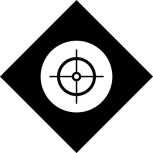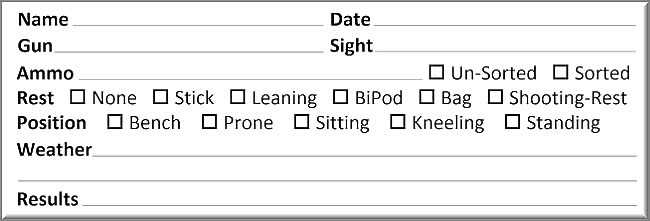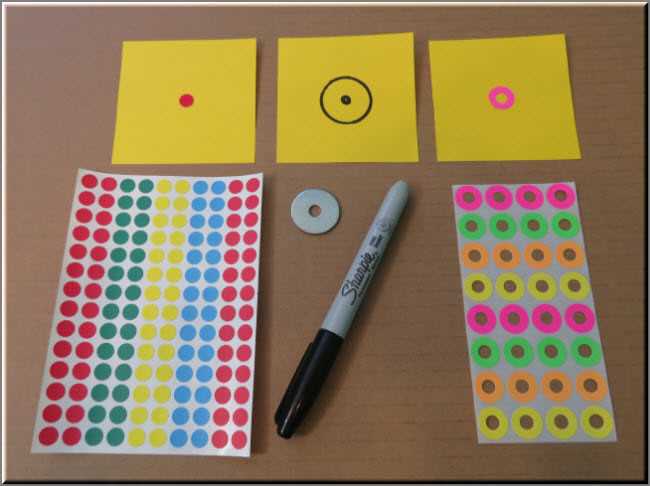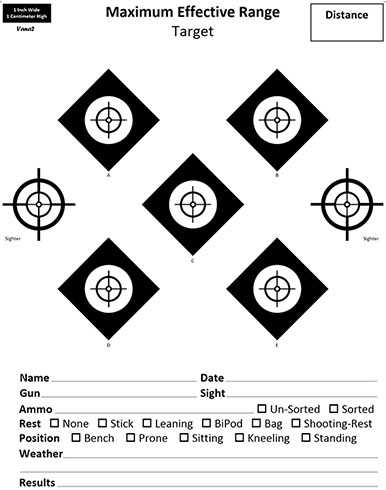This is a guest report from reader Vana2, who we know as Hank. He has often referred to the maximum effective range and today he explains it to us.
If you’d like to write a guest post for this blog, please email me at blogger@pyramydair.com.
Take it away, Vana2.
MER, MAR and MPR for Hunting
by Hank

My MER Target.
This report covers:
- What is MER?
- MER, MAR and MPR …don’t you love acronyms?
- About the Maximum POWER Range
- Why is knowing your MER important?
- MER Preamble
- What to test?
- Targets
- Practice Sessions
- Shooting to determine the Maximum Effective Range
- Summary
What is MER?
In my comments I’ve mentioned MER several times but never really explained what it is or what it is about. MER, the Maximum Effective Range, is a methodology for evaluating a gun’s capability, and a structured approach to improve a shooter’s skill.
If I had to describe the origin of MER in a couple of words I would have to say: bottle-caps. As kids we used bottle caps as reactive targets and MER grew out of the need (obsession?) to hit that bottle cap EVERY time! Yeah, one-hundred percent isn’t realistic but don’t try to tell that to a 12-year-old-kid.
The MER methodology developed from that need. To hit a bottle-cap every time you had to be close — very close! After a while close became boring so we would take a step or two back and shoot until we consistently hit the bottle-cap again. When that range became too easy we would back away a bit more.
As could be expected, this quickly became a competition. The coveted BEST SHOT award was granted to the guy who could consistently (25 consecutive shots by our rules) hit bottle-caps at the farthest distance. You can see where this is going — status is an important thing amongst your peers.
In our group, rabbits were big game and bagging one with our low-powered pellet guns got you bragging rights. Hitting one and not recovering it was sternly frowned upon and not something you wanted to happen. To bring down a rabbit required a precise shot at close range. Those who brought home rabbits regularly were skilled hunters who knew their MER.
MER, MAR and MPR …don’t you love acronyms?
Your MER, your Maximum Effective Range, is the range at which you are CONFIDENT of making a good hit in the current conditions.
Your MER consists of your Maximum Accuracy Range (MAR) and the Maximum Power Range (MPR) of the whole system. By the whole system I mean the hardware (gun, sights, ammo); the software (the shooter) and the firmware level (the shooter’s skill). Please pardon the computer analogies; I’ve worked with them ever since they were the size of a refrigerator.
About the Maximum POWER Range
Because pellets lose their velocity/energy so quickly it is common that the Maximum Accuracy Range of an airgun is greater than its Maximum Power Range. That being said, for hunting it is important to know the maximum range at which the airgun still has adequate power to humanely dispatch the game being pursued.
In this report I’m going to focus on the accuracy side of MER. For reference, here is a link to an airgun hunting article that discusses the subject hunting with airguns in more detail.
Why is knowing your MER important?
Kenny Rogers sang it right in his song: “The Gambler”…
“You’ve got to know when to hold them. Know when to fold them. Know when to walk away.”
The same is true when hunting. It’s as important to know when to pass on a shot as it is to take it. Knowing your MER helps shooters recognize and understand the capabilities of their weapon and their level of skill. It provides a baseline from which improvements can be measured.
I have always maintained that every gun is a tack-driver — up to a certain range. That range may be measured in inches, feet or yards. Knowing the MER of the airgun is necessary for ethical hunting.
MER Preamble
The structured MER approach is designed provide the shooter (actually, their subconscious) with shooting experience from close to far.
Far makes sense but why start close? Most people think about the end (maximum limit) of their MER and forget that the distance from here to there starts at the muzzle. You should practice at all distances that you might encounter game. I’ve seen a rabbit missed at 5 feet because the shooter (me, LOL!) forgot that the pellet strikes about 2 inches lower than the crosshairs at that range!
The confidence to take the shot and the mechanics of making the shot comes from experience. Practice trains the muscle-memory and provides the experience of actually having done the shot before so you can easily repeat it. With sufficient practice, things like getting into stance and shouldering the rifle that previously required conscious actions become automatic — smoother, faster and more consistent — all of which is beneficial when out shooting. Random practice like hunting and casual plinking is useful but following a systematic approach is far more effective because the experience of shooting at progressively longer distances builds on itself.
What to test?
MER can be used to test the capabilities of the hardware (gun, sights and ammo) or the shooter. When testing hardware I use a bench rest and shoot in optimum conditions to minimize induced inaccuracies. For testing the shooter I use the same stances that would be used for hunting – typically, standing and leaning/bracing while shooting off-hand.
Accessories, weather and clothing will affect your shooting so it pays to practice with all your equipment and in hunting conditions.
If you use other positions or shooting aids (e.g. bags, bi-pods & sticks) then you should test your MER with those as well. To keep notes what I was testing I added the following title block to my MER target.

This is the title block on my MER Test Target.
Targets
IMHO, the large targets made up of multiple concentric scoring rings are fine for formal target shooting but bad for hunting. I think that a simple target – a dot for an aim-point and a small circle for reference is less distracting and easier to focus on.
I find that the smaller your aim-point is the better your focus and accuracy will be so I keep the target as small as I can and still see it clearly at that distance. For close range a simple dot works well, at longer ranges I’ll use a more visible target that still offers a small aim-point and optionally, a reference circle. Whatever you choose, it’s best to use a constant size target as it develops a feel for knowing the distance.
Most of my MER practice is informal; for a target I prefer to trace a fender washer on to a Post-it note or directly on the cardboard backing board with a black marker. Occasionally, I’ll use self-adhesive dots, grommets or even commercial stick-on targets.

Some quick targets that are convenient for practicing. At 5 shots per target, I use a lot of them.
Practice Sessions
Since the hardware is what it is and no practice is required, its MER can be determined by shooting from a bench and noting the results for future reference. These days most airguns will shoot good groups out to their Maximum Power Range and beyond. Typically, the limiting factor is the shooter’s skill, which I call the Maximum Accuracy Range.
For the shooter, MER practice is for developing good form, training muscle memory and generally gaining experience in shooting at all distances.
To fully benefit from practice sessions, you need to start close and systematically, incrementally, work your way back. This trains your muscle memory teaches the point of impact sight picture for each distance.
I start of each practice session with some casual plinking to warm up and relax. Then I shoot a few pellets at 5 feet, move back 5 feet and shoot another couple of pellets. I continue increasing the range in 5 foot increments until I reach the range where all the pellets are no longer inside my 1 inch reference circle. I’ll stay at that range until I can keep 25 consecutive shots in the targets then move back another 5 feet.
During my practice (as part of getting into stance) I’ll check the distance to the target before taking the shot. Every 25 shots (5 per target) I’ll take a break and walk down to the target and look at the results. The walk helps relate the physical distance to the visual estimate and inspecting where the hits are reinforces the point of impact/point of aim sight picture.
Shooting to determine the Maximum Effective Range
When I’m comfortable with the hardware and confident with my shooting at that distance I will shoot a formal MER target.
When evaluating the results of a session I don’t score targets for points or measure group size. I measure the distances from the Point Of Impact (POI) to the Point Of Aim (POA) total them up and average them. That number is good for reference as it tells me how much off the aim point I’ll likely be at that distance.

My MER Test Target.
My formal MER target has five targets and two sighters. The target consists of a 1-1/2-inch black diamond for reference with 1-inch white circle in the center, a half-inch circle with cross-hairs and a 0.100-inch x 0.050-inch donut as the aim-point. Depending on your quarry, you might want to create a different sized target.
A session is five targets, five shots per target for a total of 25 shots. To pass all 25 shots must be in the white 1 inch area — just like the old bottle-cap days.
Summary
On a MER target a perfect score would be ZERO –- 25 shots stacked exactly one on top of the other. I can do that at 10 inches and maybe at 10 feet, but it’s not likely to happen at 10 yards. However, it’s still fun to try for one-hundred percent, even if it’s not realistic.
For hunting, if I can keep my hits within a 1 inch circle, that’s reasonable and I’m good to go …at that distance, shooting off-hand, in those conditions – because that’s my MER.
Hope this is of interest!
Cheers!
Hank


Hank,
MER, yup. How about a guns ability to reach out? That is why I am glad that B.B.
has started doing 50 yard tests. Hopefully with the powerful PCP;s he will start doing one hundred yard tests.
-Y
FWIW-My max hunting range is 45 yards with less than 10 mph wind, less if wind is stronger.
Yogi,
I’m with you, I can manage about 45 yards for hunting if there’s a convenient tree to lean on. Typically, most of my shots are in the 5 to 20 yard “comfortable off hand range”.
Yeah, airgun power, range and accuracy has dramatically improved in the past decade. Used to be that 30 yards was far, now 50 is doable and 100 not unreasonable.
Still, I think that hunting at distances beyond 50 yards is getting to be more like bench shooting as bipod and rests are pretty much mandatory at those ranges.
Interesting times.
H
Hank
I pretty much have the same story as you. Good report.
Hank,
Thanks for the explanation regarding the process of how you came about to determine the MER, MAR and MPR. Lots of food for thought for beginners, especially if they are thinking of hunting ethically. Just because your rifle is powerful don’t mean a thing if you can’t hit what you are aiming for especially if you only practice on a bench.
Siraniko
Siraniko,
I had kinda written this blog with beginners in mind as most more experienced shooters have developed a similar methodology. Thought that it might help people get off to a good start.
I wanted to include my instinctive aiming methods because that might have been interesting for more advanced shooters but that would have made this blog into a two or three part series.
The concepts are easy to demonstrate (everybody already uses them, they just need to be tuned to shooting) its that they are very difficult to convey via text. Still thinking if I want to attempt a guest blog on that subject.
H
Vana2,
I think the SECRET to learning Instinct Shooting is all the other things that (should) come before. Throwing things (not just rock and ball) with BOTH of your hands, arms, and BODY. Then adding accessories like slings, slingshots, atlatl, bows and finally guns.
The relative complexity of guns are just too distracting to allow getting the basics of instinctive targeting down pat.
shootski
Shootski,
That’s the secret, I agree totally!
At the most basic level, you look at the target then hit it.
…And thanks for mentioning atlatls. It’s been years since I’ve used one and you just added making one to my already too long project list 😉
H
Hank I have one made of wood that doubles as a Storm Paddle given me by an export from the really far North. But it has been to Sea a few times to many so: https://www.2daydeliver.com/product_detail.php?id=SKUB07CBQNCYQ&last_node=Arrow+Parts+%26+Accessories&click_src=googleads&gclid=CjwKCAiAgbiQBhAHEiwAuQ6BkntvQZK6lT58m5SmuR5p7cTctpSwUa0jjddGEvGtVoRhQ7tVEs1y6hoCe4sQAvD_BwE
Interesting concepts that would be hard to get with wood.
It may also be modernized with current Epoch materials.
I know you love wood but my last wooden boat was decades ago. No way i want take boat off car roof saddles, then carry to the water, paddle, carry from water to car, put back on roof a 90+ pound wooden kayak when I can put my 18′ 43 pound kayak there with one hand behind my back.
Actually sounds like the throw efficiency of the high tech atlatl is more stable cold, wet, or bone dry!
You don’t need to put this one on you to do list either.
shootski
As usual I am late to the game….
Great article Hank, lots of good information for software of all abilities,,,,
Once I know what the mechanism is capable of, I like to shoot reactive targets.
When I am on a closed range or on private land I will walk out in the field and set out spinners or falling targets at random places.
Then as I am walking around I will choose a target, estimate the range and shoot the smallest of the spinners I think I can hit.
It’s a yes or no feedback, it rings or I missed..
Again, great article!
Ian
Hank,
Thans for good report. My method for checking myself is similar, except I shoot 10 times at one target which is usually a small dot inside 1 inch circle, sometimes there is one more circle like 2 or 3 inches diameter. What is the hardest thing you have to face at the end of this excersise: the result. It is nothing you can compare to benchrest shooting. I shot 10times in below 0.5 inch at 50yards from benchrest. Then did the excersize free hand standing position… dissapoitment it may be called.
Recently I “forced” myself to shoot 10yards standing position free hand. After few months and approx. 20k pellets accelerated I’m better than I ever was shooting this position. Just now I realized how much I was missing mostly shooting benchrest. 🙂 And to do the training you don’t need a big distance. The improvement will come anyway for the whole range but – you need to practice regullary. 🙂 Now I like to shoot standing position a lot.
tomek,
“Then did the excersize free hand standing position… dissapoitment it may be called”
Agreed!!! I find that shooting free hand is always a good lesson in humility 🙂
As I mentioned in the blog, I deliberately shoot at various distances. I found that if I only shot at one distance I became locked in at that range and started thinking in terms of how this shot (at a different distance) differed relative to my usual distance instead of evaluating the hold-over or hold-under relative to where I was standing.
I don’t believe that you had to “force” yourself to shoot 20k pellets 😉 …With me it’s “where did all these empty pellet tins come from?” LOL!
H
Exactly 🙂 That’s why “forced” and not forced 🙂 I still don’t know what to do with all these empty tins. They are a good target but… Need to check what the other guys are doing with them.
Tomek,
Family and friends have found the pellet tins useful for storing small objects. I use a lot of them in the workshop as well.
I shoot mostly JSB and found that putting some hot water in the lid softens the adhesive and makes it easy to remove the label in one piece.
H
Thank you 🙂
Hank,
Awesome report! I like to use the 3/4″ price dots colored black with the Sharpie for open sights. They show up good that way on cardboard or paper and I try to keep all of my shots in that dot. After 25 yards, that dot is hard to see clearly with just the open sights.
When using a scoped air rifle, I use an X for my aimpoint and I try to keep all my pellets within a dime sized group. Benched or prone, my MER is between 50 and 75 yards, but sitting or standing with rest it drops to between 25 and 50 yards.
RR,
Glad you liked the report – as another addicted plinker I guesses you might 🙂
The price dots work well. A quick and lazy way I like to make targets is to punch an array of 5 holes in a sheet of thin cardboard or plastic with a piece of sharpened pipe and use it as a spray-paint mask. A minute with a rattle-can of your favorite fast drying primer and there’s a couple of dozen targets done.
I use the dot for my aimpoint, the 1/2″ circle is my target and the 1″ circle is the acceptable tolerance area (’cause its still in the kill-zone).
Yup, about the same MER as you. Going to see if I can get to 100 from the bench this summer.
H
My HM1000X in .357 will do five in 1″ at 100 yards. That is a long way away.
NICE!
I was considering a HM1000X in .22 but the local supplier said that they weren’t tuner-friendly and I do like tinkering.
I’m working my way out there with the .22. Haven’t tried the .25 though I plan to this summer.
H
Oh, I do not know about that. The hammer spring is real easy to adjust. Now the regulator is trickier as you have to pull it out to adjust it. Also, with the smaller calibers, .177-.30, you can swap barrels, bolt probes and magazines to go from one to the other.
By the way, Martin still makes them.
https://airguns-usa.com/index.php
The heavier .22 pellets may work for you. You may want to pay attention to Matt Dubber and a couple of those other South Africans that are using Impacts. The biggest caliber they can use with air rifles is .22.
RR,
I was wondering if you could swap calibers on your .357. Think that that is the same thing with the FX airguns, you can easily swap up to a certain caliber then you get into internal changes.
I watch some of the SA videos, beautiful scenery down there. The extreme performance they get out of a .22 is impressive – from a technical standpoint but I’m less than impressed with their habit of shooting at birds at ranges where a hit is more luck than accuracy. They have the equipment and a lot of experience/skill but I have to wonder how many shots (and poor hits) they make to get enough footage for the video. Maggie is the best shot of the bunch, she shoots within her MER and (usually) makes a solid hit in the vitals.
Nothing wrong with shooting paper at extreme range (getting into that myself) but I think that some of these channels are misrepresenting airguns (to newbies) and should tone it down to more realistic levels. A guy I used to hunt with came over to try my Impact because he wanted to get one to “shoot pigeons at 200 yards”. This from a guy who can’t hit a 5 gallon pail at 50 yards to save his life. A session on the range made it clear that he couldn’t buy a “200 yard pellet gun”, that he needed to learn to shoot first. …he liked my HW50 and bought one so I think he’s starting off on the right foot.
Anyway, my .22 Impact is tuned to ~ 45 fpe with Monster Redesigns and I’m happy with that. Want to try slugs for a giggle but will be staying with pellets.
I’m sorta curious about a big bore airgun. Maybe, but right now I have more than enough on my plate with my .22’s 🙂
Have a great day RR!
H
Hank,
I cannot the calibers to the other HM1000X as this block is larger than the other calibers. They can get away with it on the Impact as it is really a little barrel sleeve.
I could do it with my Maximus, but I like it at .22. It is an awesome little air rifle. Now I would like to sell / trade my HM1000X. I would end up with a Texan LSS in .457. My HM1000X is extremely accurate, but lacks the power I feel comfortable with shooting medium to large game.
Not only is your report of interest, but also very useful to FM, Hank. Good tips there – going to use your method to figure out that personal MER. FM has been stubbornly shooting only at 25 yards using pistol targets, unrealistically going for hitting the bullseye every time, but though this can be a little frustrating, it is also somewhat addictive. FM is hard-headed. On the positive side the practice keeps him from getting totally rusty. Good idea on using those Post-It Notes; going to pick some up for the backyard shooting range.
FM,
Glad you liked the blog!
The best cure I’ve found for target frustration is to cheat …stand so close that you can’t miss the darn thing then as your comfort allows, move back a bit at a time 🙂
Think that cheating is a good thing… frustration can cause tension, which increases wiggle-wobbles, which can cause bad habits.
H
Agreed. At least at 25 yards, ole FM is able to achieve fist-sized or squirrel/iguana torso sized groups; trime-sized ones? Maybe in The Next Life, if there’s airgun shooting going on there.
BB,
Please advise IT that today’s blog and over half of the comments on yesterdays blog are only available to user’s that are logged in. – Don
Don,
Done.
BB
BB,
Fixed. Thanks. – Don
Vana2,
Great blog!
We have discussed Off Line a number of times but you have made it accessible in this Guest Blog to all levels of airgun Marksman!
shootski
Thanks shootski!
MER is the easy part – the instinctive part is easy to but it’s going to take some explaining!
(No reply option above) Thanks for the link but its too late about the atlatl, just came in from the garage with a piece of buckthorn that should do just fine 🙂 Think I’ll split some cedar for making the darts; got deer leg-bones for the points and turkey primaries if I want to fletch them …but (as my wife reminded me) I’ll finish painting the guest room first.
A lot of wooden boats are heavy but they don’t have to be. The “Chesapeake” 17 foot kayaks I make are usually around 40 pounds and my 18 foot cedar/spruce canoe (38″ beam, 16″ depth) weighs 56 pounds.
H
Hank,
She is beautiful!
Easy!
But first you need to find where you left your instincts in this modern World.
Get that painters’ cap on PRONTO!
shootski
That is a beaut indeed. Reminds FM he is going with his Usual Suspect friends on a canoe trip on the Peace River in FL the next few days and really looking forward to that. Our canoes won’t be as pretty as the craft displayed here, but they’ll have to do.
FM,
You will have great fun! Bugs are still under control and temperatures and humidity are not overwhelming. Don’t feed the gators.
Are you camping and doing most of the 65+ miles of the river water trail? My son and I did the whole river from lake Hamilton before they restricted water outflow to keep the fish in the lake happy with deeper water. We did it in three days during a “cold” 60°F December.
shootski
Shootski, this is FM’s third trip since ’96 on the Peace River; we’re camping but going only from Zolfo to Gardner which is about a third+ of the distance for the water trail. There is a “little” problem right now, the water level being too low requiring portaging…so we may postpone. We’re not into replicating Lewis and Clark or DeSoto exploration experiences at this point. The other alternative we do have is Fish Eating Creek, which you likely know about. We will make the best of it.
Beautiful canoe!!! 🙂
“You’ve got to know when to hold them. Know when to fold them. Know when to walk away.”
Hank,
Thank you for using that line from the Kenny Rogers song…my Mom loved him, and that was one of her favorite songs…good memories.
I thoroughly enjoyed today’s report; you did a much better job of articulating a practice I’ve been following: I like to sight in air rifles from the bench to see what they can do, then try them offhand, and sitting, and from improvised rests to see what I can do. For pesting, my MER is only 15 yards when shooting offhand; and I have two rifles with more than sufficient power for longer range, but they both have an MER of 30 yards max (from sitting position); one MSP is limited by the iron sights, and one spring piston one is limited by the firing jolt (even though I use the artillery hold and even after it has been tuned). The main reason I ordered a Seneca Dragonfly Mark2 is that I hope, scoped, I can tweak it to a MER of 40 yards (of yes, I use your 1″ criteria for MER).
Well, that’s the long version; short version: great report! 🙂
Cheers!
dave
P.S. I still hope you do another report on instinctive shooting. 🙂
Glad you liked it Dave.
Yeah good song. Been listening to a lot of old songs of late, don’t like the new stuff. Not surprising, my parents said the same thing about my music 🙂
Will think about the instinctive shooting report.
Cheers!
H
“Will think about the instinctive shooting report.”
Cool; I understand it would not be an easy report to write; but I believe it would be very well-received by the readership here. 🙂
Bottle caps…brings back memories of my Uncle teaching me to shoot off hand 40 years ago, God rest his soul. He nailed a cheap 1 cup metal measuring cup to a tree, and had me shoot at it from like 10 or so yards away, and as I began to ping at that cup consistently, he would have me take a step back. If I missed, I would take a step forward. I got pretty good with that Crosman 760, and built up my muscles too from all that pumping! I’ll never forget that sound, like a bell when the pellet connected with that metal cup. Good memories.
Great stuff! I love stories like this; thank you! 🙂
Know what you mean about the sound Roamin, I like to suspend small metal targets for that exact reason.
H